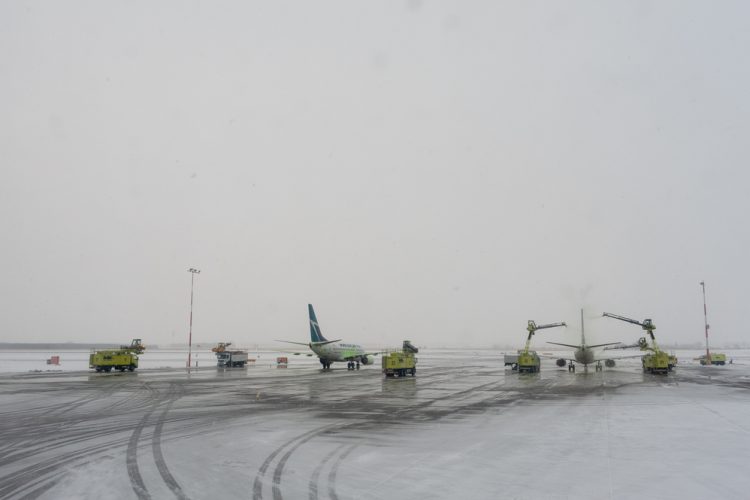Staying open in extreme winter weather
- Like
- Digg
- Del
- Tumblr
- VKontakte
- Buffer
- Love This
- Odnoklassniki
- Meneame
- Blogger
- Amazon
- Yahoo Mail
- Gmail
- AOL
- Newsvine
- HackerNews
- Evernote
- MySpace
- Mail.ru
- Viadeo
- Line
- Comments
- Yummly
- SMS
- Viber
- Telegram
- Subscribe
- Skype
- Facebook Messenger
- Kakao
- LiveJournal
- Yammer
- Edgar
- Fintel
- Mix
- Instapaper
- Copy Link
Posted: 22 December 2023 | Dean Ervin | No comments yet
Dean Ervin, Director of Aerodrome Operations, Safety and Compliance at Edmonton International Airport (YEG), discussed in Issue 3 how to operate Canada’s most northern-based major airport and staying operational during extreme winters.


YEG is converting one of its Runway Truck and Sweeper units to a Hydrogen Dual Fuel operation. A first of its kind for winter operations equipment, this new technology will lead the way in reducing emissions from the fleet. CREDIT: YEG
In temperatures below -30 degrees Celsius with blinding snowstorms, howling winds, freezing rain and snow-covered landscapes as far as the eye can see, passengers at Edmonton International Airport (YEG) continue to arrive safely and take off.
As Canada’s most northern-based major airport, YEG’s winter operations crew is dedicated to keeping planes and passengers moving. They are ready to tackle any extreme weather condition during Edmonton’s long snow season, usually lasting from October to April, with about 140 days per year with snow on the ground.
Surrounded by prairie landscapes with lots of open space for winds to blow snow in from the fields, the airport is situated on roughly 7,000 acres outside the urban sprawl. Temperatures are known to plunge below -40 degrees Celsius in this rural area during the coldest months of the year.
Yet, even during the most extreme weather conditions with the coldest of temperatures, YEG has never closed. In fact, you will find the airport’s aprons and runways in pristine condition.
Staying open in extreme weather conditions?
Ensuring planes take off and land through extreme winter weather has zero room for error. A safe, efficient response to adverse weather conditions requires deep knowledge for winter operations, months of pre-preparation and concentrated training.
YEG’s most valuable asset is our highly skilled winter operations team, keeping the airport operating 24/7, 365 days per year. Fully trained and tested for the winter season, our team is ready for whatever Mother Nature decides to throw our way.
When a storm is rolling in, our crews are ready to move. Carefully monitoring the forecast, if there is potential for rain or freezing rain, we spray our runways and aprons with a potassium acetate solution that stops ice from forming. This is an extremely valuable pre-emptive line of defence.
Timing is the most significant factor, and our crews work 12-hour shifts around the clock. Our fleet of snow clearing vehicles work in orchestrated precision to keep runways and aprons safe for aircraft. We constantly debrief, evaluate performance and adjust our plan of attack depending on the type of weather we are facing.
YEG’s most valuable asset is our highly skilled winter operations team, keeping the airport operating 24/7, 365 days per year.”
The winter of 2022 was a true test for airports across Canada, with massive storms, predominantly freezing rain, causing a ripple effect of flight delays and cancellations. However, winter storms such as these are familiar to YEG. We have faced enormous ice and snow events in the past, including one year when it snowed for 24 days straight, accumulating over 200 cm of snow over that season. In these weather situations, YEG is ready to go with our experienced team and all hands-on deck. If it means we have to recruit people from other airport teams, we will do that too. If you can operate a shovel, you will be drafted to help clear snow to keep people moving safely and efficiently.
Using technology and data to predict conditions
YEG’s winter operations crew has many tools in the toolbox to keep us nimble. One key tool is our access to various technology, helping us be exceptional in our snow and ice response. We rely on numerous weather monitoring and predicting tools such as Environment Canada, Weather CAN, Wx Weather Sentry, Vaisala, NAV Canada AWWS-Forecasting, Weather Network and Doppler Radar.
Data-driven technology platforms such as our Vaisala Runway system give us real-time information on the substrate, allowing our team to make predictions about conditions, response times, chemical applications required and any precipitation levels present.
We also look to the past to predict the future, researching decades of extensive historical weather data to monitor trends and adjust to changes. Having historical weather data available allows us to analyse climate change, predict potential winter storm scenarios, and proactively plan for and practice our responses.
Training, practice and forward thinking
YEG’s winter operations training programme is continuous, year-round, starting with leadership and cascading to all team members, including lead hands, operators and labourers. Our crew receives classroom instruction and extensive real-time, scenario-based operational practice. We know that all winter storms have unique factors, and our team is trained to face a variety of extreme weather scenarios.
We always look at new technology processes, procedures and techniques to improve our operational readiness and response. Recently, YEG developed and implemented a new strategy for our winter operations crew to have access to real-time training materials. We placed QR codes on all our winter equipment, and team members can simply scan the code and access valuable training materials to provide guidance for safe operations.
Winter operations and sustainability in mind
YEG is committed to being net zero by 2040. As the world’s first airport to sign Amazon’s climate pledge, we look for ways to change our winter operations practices for a greener future.
Being a winter airport means we use over three million litres of Type I and Type IV glycol de-icing fluid between September and May every year. With our on-site recycling partners, we have been able to collect almost 50% of the spent de-icing fluid for recycling and reuse. The rest that is not captured goes to our storm water treatment facilities.
YEG was also one of two airports in Canada to trial Aero-Mag’s all-electric de-icing vehicle. It’s the first of its kind for the Canadian company, which usually runs diesel-powered trucks for de-icing. Aero Mag aims to reduce greenhouse gas emissions as much as possible through a complete transition towards an electric de-icing vehicle fleet.
Currently, YEG is converting one of our Runway Truck and Sweeper units to a Hydrogen Dual Fuel operation. A first of its kind for winter operations equipment, this new technology will lead the way in reducing emissions from our fleet.
YEG makes a point to purchase the lowest emissions vehicles for our winter operations when possible, and we also monitor the idling of our fleet, making logical reductions.
Preparing for future winters
One thing that will always be around is Edmonton’s winters. We prairie-living Canadians are known to be tough in the winter, poised and ready for extreme conditions. In Edmonton, we never shut down because of ‘a little’ snow, and this also applies to our airport. We also know the weather is unpredictable and the climate is changing drastically.
As a northern based airport, we must do everything possible to prepare for any type of winter weather situation. YEG is focused on embracing the future by using technology and innovation to change how we do business, including our winter operations plan. Our team is constantly seeking new and innovative ways of being better at tackling winter weather at our airport.
YEG is already an industry leader with adopting drone technology in airport operations. We are the first airport in Canada to offer commercial drone delivery operations in a controlled airspace. We also use a specialised drone to conduct runway safety inspections and a drone mimicking a falcon to deter birds around the airport. Drone technology is certain to shift how we manage winter operations, and we are currently looking at how we can use drones to monitor winter weather data in real-time.
The cold doesn’t bother us at YEG! We are exceptional at managing our winter airport and are proud to have always stayed open despite drastic winter weather conditions. We never cut a single corner when it comes to safety, and it will always be our number one priority when facing whatever cold spell Mother Nature decides to cast on us.
About the author


Dean Ervin has expertise in aerodrome operations, safety, and regulatory compliance requirements. He has 27 years of experience in aviation at Edmonton International Airport (YEG). He started in the structural department and is now Director of Aerodrome Operations, Safety and Compliance, focused on aerodrome operational and safety activities at Edmonton International Airport (YEG) and Villeneuve Airport (ZVL). He oversees creating and implementing core airfield maintenance, regulatory and safety programmes in accordance with Transport Canada standards and regulations and service level expectations. He develops, implements, and reviews the Operations and Maintenance processes to ensure compliance with policies and regulatory requirements and mitigates risks. He is currently the Canadian Airport Council- Ops and Technical Advisory Committee Chair.
Dean is passionate about developing and monitoring operational initiatives to enhance the efficiencies of operational tasks and regulatory requirements in the aerodrome aviation space. His favorite motto is: how do we get to ‘YES’ for a safe, efficient and effective industry outcome?
Issue
Related topics
Airside operations, Social responsibility, Sustainability, Terminal operations


















